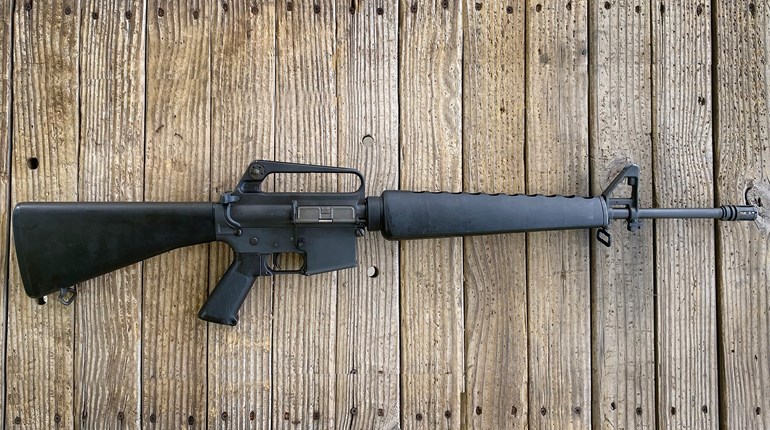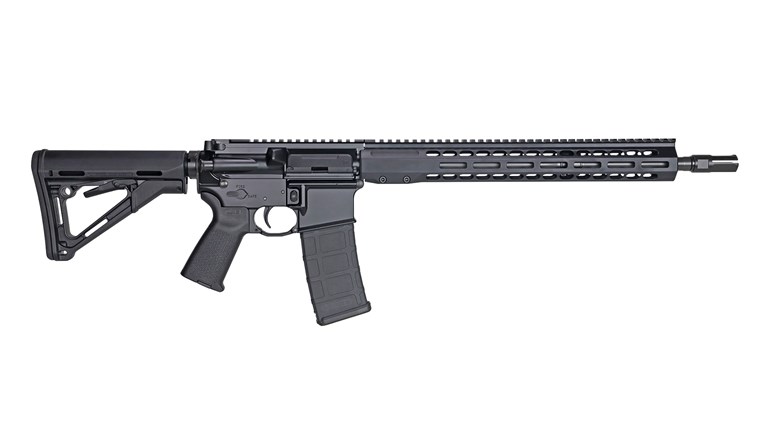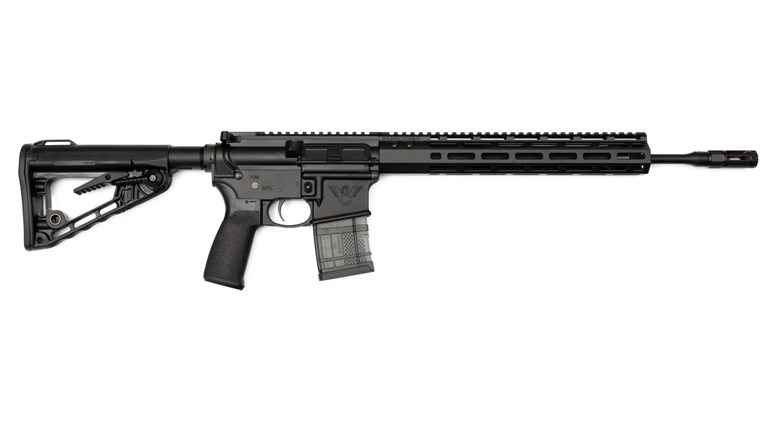
Just to make sure we’re all on the same page when it comes to the .50 Beowulf and its namesake, we all studied Beowulf in high school, right? Take a moment to recall the 3,182 lines of alliterative verse poetry written in unintelligible Old English. Got it fresh in your mind? Good.
OK, so to be honest, I didn’t pay attention in English Lit class either. To get us all on the same page, here’s the social-media-friendly, condensed version of the story. Danish King Hrothgar’s beer hall was under attack by a demonic monster. Yes, the beer hall was really under attack. Maybe this story should have been a Greek tragedy. Anyway, a Scandinavian badass, Beowulf, comes along to kick the monster's butt, successfully I might add.
This royally ticks off the monster's mom (yes, really), so Beowulf uses a giant sword to slay her, too. The people are so happy that the beer hall was saved that they eventually make Beowulf King. Later, to get the renewal on his man card, he has to travel somewhere to slay a dragon but is mortally wounded in the process. Bottom line: Beowulf is an epic, but dead, folk hero with valid monster-slaying certificate of participation. If you want to win trivia bar bets, the monster that Beowulf killed was known as Grendel. You might recognize that name from another cartridge developed by Alexander Arms.
So given the attributes we’re going to discuss, the Beowulf name seems entirely appropriate. I’m thinking that the original Beowulf would have much rather entered that dragon’s lair with an Alexander Arms .50 Beowulf. He probably wouldn’t have even needed a spare magazine and would be alive drinking Danish ale today.
What’s the .50 Beowulf?
In short, the .50 Beowulf is an elephantine round designed to increase stopping power of an AR-15-platform rifle by a factor of 10 billion or so. The cartridge is just short enough to fit in a standard AR magazine, although for obvious reasons (it's fat) it won’t double stack like .223 Rem./5.56 NATO cartridges. Developed by Alexander Arms, this cartridge is a tapered, straight-wall case topped with, you guessed it, a .50-caliber projectile. So that it can use a 7.62x39 mm bolt face, the case rim is rebated, or smaller than the case body. This not only allows use of a “more standard” bolt, but it also allows that bolt to have enough metal on it to withstand pressure over time and use.
As for the launcher part, Alexander Arms offers both complete upper receivers and fully-built rifles. If you go the upper receiver route on a lower of your own, you’ll need the installed barrel with the much bigger hole. What’s not as obvious is that the Alexander Arms upper receivers include a bolt carrier and bolt compatible with that 7.62x39 mm rebated cartridge rim. What’s even less obvious is that the Alexander upper has an enlarged ejection port. Those cases are on the chubby side and need a bit more elbow room to escape.
Most of the current upper-receiver models include 16.5-inch barrels. However, if you’re in the door-kicking business, you might be interested in the 12-inch barrel version. Unless you configure the world’s most unwieldy AR pistol, you’ll need to obtain an ATF short barrel rifle tax stamp for that one. The pre-built rifles all sport 16.5-inch barrels and come in a variety of fixed and adjustable stock configurations. All of them are flattop receivers, but you can certainly stick that classic AR carry handle on if want to be a purist tactical poet.
.50 Beowulf: Poetry in Motion
Think of the .50 Beowulf as a monster pistol cartridge that delivers the approximate performance of the old .45-70 workhorse. The most common loadings have 300- to 500-grain projectiles, and they move fast enough to deliver some serious thump. For example, at the low end, the 300-grain bullet leaves a 24-inch barrel at 1,870 feet per second and packs muzzle energy of 2,330 foot-pounds. The 400-grain load travels at 1,875 fps and delivers 3,123 foot-pounds at the muzzle.
When I said “lob” earlier, I meant it. That 400-grain soft-point load drops almost 12 inches by the time it travels 200 yards when zeroed for 100. By 300 yards, we’re looking at a 46-inch drop. That’s also about the distance where kinetic energy drops below 1,000 foot-pounds.
What does all that mean? Let’s put it in perspective comparing it to something we all know and love: a 12-gauge slug. A 438-grain slug leaving the barrel at 1,610 feet per second carries 2,520 foot-pounds of muzzle energy. While the projectile weights are in the same ballpark, the .50 Beowulf is going to deliver longer range and better accuracy. And it’s an AR, so you get all the bennies like box magazines, accessory rails, adjustable stocks and aftermarket performance-enhancing parts. Speaking of box magazines, the company offers an optimized version but the round will work with standard GI magazines. Given the corpulent nature of the round, a full-sized magazine will hold 10 cartridges.
What's the .50 Beowulf Good For?
Given the big, fat bullets and higher side of moderate velocity, it’s a great overall short-to-medium-range cartridge for all sorts of stuff.
On the hunting front, especially considering its bullet variety, it’ll handle pretty much anything north of the equator between Hawaii and Ireland. Not that large game outside of that isn't applicable. Bear hunting or protection? Check. Hogs? Check. Hogzilla? Double check. Moose? Yep. Deer? Ha! Don’t insult the cartridge, please. Will it take out a Grendel? Sadly, we’ll never know. I do have one gripe on the Beowulf’s appropriate game list. As I write this, five separate Sharknado movies have been released, and I’ve yet to see this rifle and cartridge featured in any of them. Seems like the perfect Great White solution to me, but then again, I’m not a Hollywood gun expert.
On the defensive and tactical side, those big bullets carry a lot of momentum, so they’re good for applications where penetration is required. If the requirement is to zip through heavy vehicle glass, the .50 Beowulf will do that with minimal, if any, bullet deflection. If a related requirement calls for going into vehicle interiors without using the handles — meaning right through the doors or body, the same benefits apply. Using the proper bullet that’s designed to remain in one piece, there’s plenty of momentum to get that job done too. A couple of frangible loads are available for door lock busting and training use.
.50 Beowulf Ammunition
As a proprietary cartridge, ammunition choices are somewhat limited. Since the bullet is .50 caliber, you can easily find projectiles if you choose to reload, and Alexander Arms and others publish tested reloading data. As for factory ammunition, you can find a few different options like these.
Inceptor Ammunition offers a load using its ARX projectile. This novel bullet type is injection molded from a blend of polymer and copper. It’ll fragment against hard surfaces like steel, but for organic targets, its drill-bit-like shape is designed to transfer energy to the target using fancy fluid dynamics. The .50 Beowulf load features a 200-grain ARX bullet that leaves the muzzle at 2,500 feet per second, yielding 2,776 foot-pounds of kinetic energy.
Precision One loads a round using Hornady’s 350-grain XTP Magnum hollow point projectile. Matched with Starline brass cases, this one is rated at 1,830 feet per second.
If you want to go straight to the source, Alexander Arms offers a variety of options for different purposes. Interestingly they also produce a cartridge using the Inceptor ARX 200-grain bullet. Their more conventional offerings include FMJ, 100-percent brass, jacketed hollow-point, and soft-point bullets ranging from 335 to 400-grains.
One thing we haven’t yet mentioned is the cost, and I’m not talking about money. Both the uppers and rifles are priced reasonably. I’m referring to recoil. It’s just a tad more than the .223 cousin. While felt recoil depends on a lot of factors like the recoil impulse velocity and time curve, one way to objectively compare recoil is to look at the raw recoil energy figures.
Let’s assume an eight-pound rifle for all these examples since what you feel varies with rifle weight. A regular .223 rifle will deliver between two and four foot-pounds of recoil, usually in the three-plus range for most loads. A .308 Winchester ranges from 11 to 18 with most loads in the 15 and 16 foot-pound range. The Beowulf clocks in with 18 to 30 with most ammunition coming in around 25 foot-pounds. Most 12-gauge 2 3/4-inch shells will generate recoil energy in the mid-20s depending on the ammo, so that gives you a decent comparison. The bottom line is that a muzzle brake will be your friend even if it does frustrate your range neighbors.
Grendel and his cranky mom have already been dispatched by the Beowulf, but there’s still plenty of perfectly good applications for this thumper. Because… why not?




































